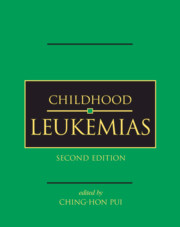Book contents
- Frontmatter
- Contents
- List of contributors
- Preface
- Part I History and general issues
- Part II Cell biology and pathobiology
- Part III Evaluation and treatment
- 14 Pharmacokinetic, pharmacodynamic, and pharmacogenetic considerations
- 15 Assays and molecular determinants of cellular drug resistance
- 16 Acute lymphoblastic leukemia
- 17 Relapsed acute lymphoblastic leukemia
- 18 B-cell acute lymphoblastic leukemia and Burkitt lymphoma
- 19 Acute myeloid leukemia
- 20 Relapsed acute myeloid leukemia
- 21 Myelodysplastic syndrome
- 22 Chronic myeloproliferative disorders
- 23 Hematopoietic stem cell transplantation
- 24 Acute leukemia in countries with limited resources
- 25 Antibody-targeted therapy
- 26 Adoptive cellular immunotherapy
- 27 Gene transfer: methods and applications
- 28 Minimal residual disease
- Part IV Complications and supportive care
- Index
- Plate Section between pages 400 and 401
- References
26 - Adoptive cellular immunotherapy
from Part III - Evaluation and treatment
Published online by Cambridge University Press: 01 July 2010
- Frontmatter
- Contents
- List of contributors
- Preface
- Part I History and general issues
- Part II Cell biology and pathobiology
- Part III Evaluation and treatment
- 14 Pharmacokinetic, pharmacodynamic, and pharmacogenetic considerations
- 15 Assays and molecular determinants of cellular drug resistance
- 16 Acute lymphoblastic leukemia
- 17 Relapsed acute lymphoblastic leukemia
- 18 B-cell acute lymphoblastic leukemia and Burkitt lymphoma
- 19 Acute myeloid leukemia
- 20 Relapsed acute myeloid leukemia
- 21 Myelodysplastic syndrome
- 22 Chronic myeloproliferative disorders
- 23 Hematopoietic stem cell transplantation
- 24 Acute leukemia in countries with limited resources
- 25 Antibody-targeted therapy
- 26 Adoptive cellular immunotherapy
- 27 Gene transfer: methods and applications
- 28 Minimal residual disease
- Part IV Complications and supportive care
- Index
- Plate Section between pages 400 and 401
- References
Summary
Introduction
The possibility that the immune system can be harnessed to play a role in eradicating leukemia has long been an attractive concept. Numerous experiments in animal models have convincingly shown that T lymphocytes recognize and kill malignant cells. However, human immunotherapy with nonspecific stimulants, such as BCG (Calmette–Guérin bacillus), has not had a successful history. In the last few years, improved knowledge of the molecular basis of antigen presentation and T-cell recognition of antigen has made it clear that many tumors possess antigens that could be targets for activated T cells. Interest in cellular immunotherapy has also been stimulated by clinical studies showing the efficacy of unmanipulated donor T cells as therapy for relapse after allogeneic bone marrow transplantation. In this chapter we review clinical immunotherapy strategies now being applied in the treatment of leukemia.
Immune system recognition of tumor cells
Recent advances in basic immunology have provided important insights into the mechanisms by which the immune system recognizes tumor cells. Dissection of the processes of antigen presentation and T-cell recognition of antigen has yielded especially useful information in this regard. Advances in genomics have also simplified the identification of putative tumor antigens through the use of new informatics tools to deduce epitopes from candidate genes.
Antigen presentation
Antigen-presenting cells recognize either endogenous cellular proteins or exogenous proteins, such as tumor debris, process them into short peptide fragments, and then present these fragments on the cell surface in association with MHC molecules for subsequent presentation to T cells.
- Type
- Chapter
- Information
- Childhood Leukemias , pp. 648 - 660Publisher: Cambridge University PressPrint publication year: 2006



